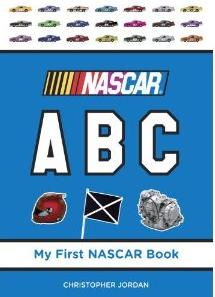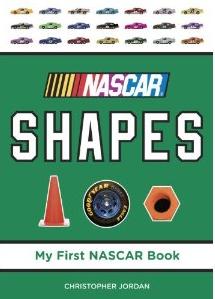| ________________
CM . . .
. Volume XIX Number 12. . . .November 23, 2012.
excerpts:
Jordan, the author of the six books in the “My First NHL Book” series, has elected to use another professional sport, car racing, to introduce youngsters to the letters of the alphabet, numbers from one to 12, and 11 colors and eight shapes. This time, things associated with NASCAR (the National Association for Stock Car Auto Racing) are used as the sources of the books’ photographic illustrations. According to Wikipedia: NASCAR is the largest sanctioning body of stock car racing in the United States. The three largest racing series sanctioned by NASCAR are the Sprint Cup Series, the Nationwide Series, and the Camping World Truck Series. It also oversees NASCAR Local Racing, the Whelen Modified Tour, the Whelen All-American Series, and the NASCAR iRacing.com Series. NASCAR sanctions over 1500 races at over 100 tracks in 39 US states and Canada. Wikipedia also states that “NASCAR is second only to the National Football League amongst professional sports franchises in terms of television ratings in the United States.” Canadians who want to experience a NASCAR race live in this country, as opposed to watching it on TV, can attend races in the NASCAR Canadian Tire Series (NCATS) which, as of 2012, is in its sixth season. Board books are usually amongst infants/toddlers first introductions to the larger world of reading, and they are often used to introduce/reinforce some early learnings, with recognizing the letters of the alphabet and counting from one to 10 often being among the first things that parents and other caregivers attempt to teach children. With one exception, that being Vv Ww, NASCAR A B C presents one letter, in both upper and lower case, per page, and that letter is accompanied by a NASCAR related illustration placed on a solid colour background along with a sentence or two at the bottom of the page that “explains” the illustration. V&W are found on a single double-page spread that shows a racing car placed against a collage of “winners”. The accompanying text reads: “V is for Victory Lane. W is for winner. Victory Lane is where the driver celebrates after winning a race.” NASCAR A B C is definitely for the upper end of the audience range as its illustrations are frequently much too demanding for those just beginning to associate letters of the alphabet with objects. For instance, I suspect that most youngsters who first see Aa’s “automobile” will call it a car. Very few will even recognize that the silver object on the Ee page is an engine as it’s presented without a context, and the same could be said of Hh’s “helmet”. Without the text accompanying the hazy photo for Ii, I would have had absolutely no idea that I was looking at an “infield”. Frankly, Oo’s “oval” looks more like a pizza than an overhead shot of a race track. Jordan over-stretches his young readers when he uses concepts, rather than concrete objects, to illustrate a letter. Ss is for ”speed”, and youngsters are to recognize that the blur on the track is a speeding car, an understanding that is complicated by the fact that the following “frozen” cars can be seen clearly. Zz’s “zoom” shows a “static” car while the background crowd is a blur. Q is always a tough letter for anyone putting together a themed alphabet book, and Jordan totally bombs out with the illustration that accompanies Qq’s “qualify”. The book’s final page is a “Let’s review” that reproduces the alphabet’s letters in upper and lower case. NASCAR 1 2 3 covers the numbers from one to 12 with each number being presented on a single page or via a double-page spread. The number is presented as a number, and the words tell the reader what is to be counted. The object to be counted is presented on a solid colour background, and a single line of text contained within a white banner at the bottom of the page then says something about the thing that is being counted. For example, the connection between “2 TWO JETS” and NASCAR is explained by the sentence, “Jets fly over NASCAR tracks during pre-race activities.” Overall, NASCAR 1 2 3 is much more successful than NASCAR A B C. In the main. the objects to be counted are obvious, and, as the numbers increase, they are grouped in ways that facilitate counting. However, in a couple of instances the illustration could have been clearer. The three flags are presented on a single flag pole, and the one finish line has a white line running down its middle which could cause youngsters to see it as a pair of finish lines. A version of this same illustration also appeared in NASCAR A B C where it poorly represented Ff. The “pizza” race track from NASCAR A B C reappears in connection with the number eight, but it is appropriate in this context as it is easy to count. The final page, titled “Let’s review!”, gives children another opportunity to recount the various items. Of the four books in the series, NASCAR Colors (or Colours as we would likely spell it in Canada) is both the simplest and the most successful. Each of the 11 colours represented in the book serves as the background to pages which present one or more cars and drivers, with the target colour being a key component of the car’s colour scheme or a large part or focal point on the driver’s team uniform. The white banner text running across the bottom of the pages contains but a single word, that being the appropriate colour. The colours found in the book are: white, orange, yellow, brown, red, gray, green, pink, and black. All of the drivers shown are male, with one exception, and you can guess what colour she’s wearing. A concluding two-page spread makes up the book’s “Let’s Review!” section that utilizes just the racing cars as its illustrations. Since not all of the cars are painted in a single colour, the review could prove a challenge for some readers, especially “blue” and “purple” which might be erroneously identified as “yellow” and “white” as those two colours seem to predominate on the two-toned cars. A circle, square, oval, rectangle, triangle, hexagon, trapezoid and a star constitute the principal content of NASCAR Shapes. In the first eight two-page spreads, the left page contains the targetted shape while the right hand page has a real object, one connected directly or loosely to the world of NASCAR, that exhibits that shape. Like the other three books, each background is rendered in a single colour. The wording in the banner text underneath the shape identifies the shape while that under the real object says something about it. For instance, the real object that represents the rectangle is found in an overhead shot of a semitrailer, and its accompanying text reads, “Race cars are brought to the track in team haulers.” Of the eight shapes, half of them, circle/tire, oval/track, hexagon/lug nuts and star/American flag work really well. Square/checkered flag could be confusing as the flag, itself, is a rectangle, and the ”fluttering” flag distorts some of the black and white squares. As noted earlier regarding the rectangle, the real object has been photographed from above, a perspective not likely viewed in real life by many. While a traffic cone is triangularly shaped, it is definitely not a triangle as it has too many angles. And you try defining the shape of a trapezoid to a toddler, especially when the real life example is a car windshield - just the windshield with no context. After the eight shapes have been introduced, the next four two-page spreads are a “Can you spot the...? quiz. The left page contains three silhouettes and the right a real object. The reader is to match the real object with its correct silhouette. The task is made easier by the fact that the “correct” answer is always the middle silhouette. The injection of the silhouette of a fighter plane into two of the quizzes seems a bit odd given that the plane played no role in the shapes portion of the book. The closing “Let’s Review!” page repeats the eight shapes but, again oddly, includes four of the silhouettes, with that of the fighter plane being one of them. Of the four books in the “My First NASCAR Book” series, NASCAR Shapes is definitely the weakest and truly lacks focus and execution. The books in the “My First NASCAR Book” series are not likely the first books parents or other caregivers would present to their young charges, but, with the exception of NASCAR Shapes, they have a place in public libraries and home collections to reinforce youngsters’ learning of the alphabet, their recognition of colours, and their ability to count to 12. NASCAR A B C, NASCAR 1 2 3 and NASCAR Colors - Recommended. NASCAR Shapes - Not recommended. Dave Jenkinson, CM’s editor, lives in Winnipeg, MB.
To comment
on this title or this review, send mail to cm@umanitoba.ca.
Copyright © the Manitoba Library Association. Reproduction for personal
use is permitted only if this copyright notice is maintained. Any
other reproduction is prohibited without permission.
NEXT REVIEW |
TABLE OF CONTENTS FOR THIS ISSUE
-November 23, 2012.
AUTHORS |
TITLES |
MEDIA REVIEWS |
PROFILES |
BACK ISSUES |
SEARCH |
CMARCHIVE |
HOME |



